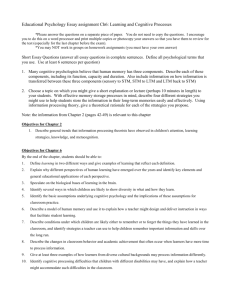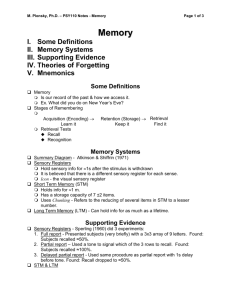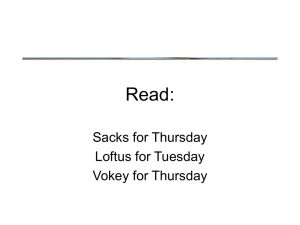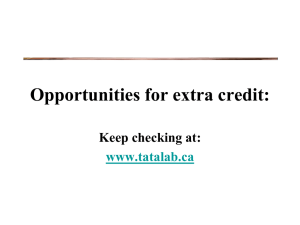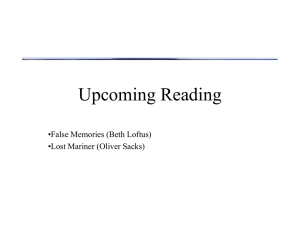T P ESTS
advertisement
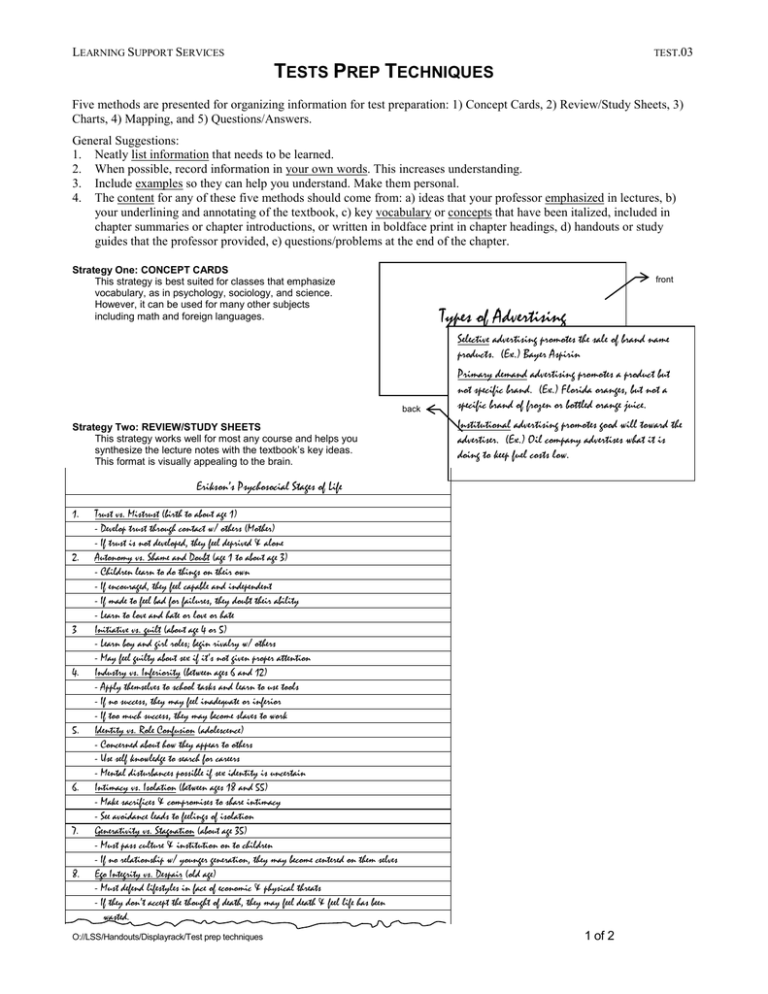
LEARNING SUPPORT SERVICES TEST.03 TESTS PREP TECHNIQUES Five methods are presented for organizing information for test preparation: 1) Concept Cards, 2) Review/Study Sheets, 3) Charts, 4) Mapping, and 5) Questions/Answers. General Suggestions: 1. Neatly list information that needs to be learned. 2. When possible, record information in your own words. This increases understanding. 3. Include examples so they can help you understand. Make them personal. 4. The content for any of these five methods should come from: a) ideas that your professor emphasized in lectures, b) your underlining and annotating of the textbook, c) key vocabulary or concepts that have been italized, included in chapter summaries or chapter introductions, or written in boldface print in chapter headings, d) handouts or study guides that the professor provided, e) questions/problems at the end of the chapter. Strategy One: CONCEPT CARDS This strategy is best suited for classes that emphasize vocabulary, as in psychology, sociology, and science. However, it can be used for many other subjects including math and foreign languages. front Types of Advertising Selective advertising promotes the sale of brand name products. (Ex.) Bayer Aspirin back Strategy Two: REVIEW/STUDY SHEETS This strategy works well for most any course and helps you synthesize the lecture notes with the textbook’s key ideas. This format is visually appealing to the brain. Primary demand advertising promotes a product but not specific brand. (Ex.) Florida oranges, but not a specific brand of frozen or bottled orange juice. Institutional advertising promotes good will toward the advertiser. (Ex.) Oil company advertises what it is doing to keep fuel costs low. Erikson’s Psychosocial Stages of Life 1. 2. 3 . 4. 5. 6. 7. 8. Trust vs. Mistrust (birth to about age 1) - Develop trust through contact w/ others (Mother) - If trust is not developed, they feel deprived & alone Autonomy vs. Shame and Doubt (age 1 to about age 3) - Children learn to do things on their own - If encouraged, they feel capable and independent - If made to feel bad for failures, they doubt their ability - Learn to love and hate or love or hate Initiative vs. guilt (about age 4 or 5) - Learn boy and girl roles; begin rivalry w/ others - May feel guilty about sex if it’s not given proper attention Industry vs. Inferiority (between ages 6 and 12) - Apply themselves to school tasks and learn to use tools - If no success, they may feel inadequate or inferior - If too much success, they may become slaves to work Identity vs. Role Confusion (adolescence) - Concerned about how they appear to others - Use self knowledge to search for careers - Mental disturbances possible if sex identity is uncertain Intimacy vs. Isolation (between ages 18 and 55) - Make sacrifices & compromises to share intimacy - See avoidance leads to feelings of isolation Generativity vs. Stagnation (about age 35) - Must pass culture & institution on to children - If no relationship w/ younger generation, they may become centered on them selves Ego Integrity vs. Despair (old age) - Must defend lifestyles in face of economic & physical threats - If they don’t accept the thought of death, they may feel death & feel life has been wasted. O://LSS/Handouts/Displayrack/Test prep techniques 1 of 2 LEARNING SUPPORT SERVICES TEST.03 Strategy Three: CHARTS These are especially useful when you need to learn information that explains how two or more, persons, places, things or theories are alike or different. This format is visually appealing to the brain. The Psychosexual Stages, according to Freud Age Characteristics Oral Stage Birth to 1 yr Anal Stage 1 yr to 3 yrs Phallic Stage 3 yrs to 6 yrs Latency Stage 6 yrs to about 11 yrs Adolescence Gets pleasure from mouth by sucking, eating, biting, and chewing Gets pleasure from holding and letting go of body waste Derives pleasure from his or her primary sex organs Child denies attraction for parent of opposite sex and identifies with parent of the same sex Awakening of sexuality and desire for sexual love Genital Stage Strategy Four: MAPPING Mapping is especially suitable for scientific and technical materials. This technique asks the learner to develop a visual illustration of the textbook content. This enhances remembering and understanding. Remember - “A picture is worth a thousand words.” EXAMPLE 1: Sequencing Freeze dehydration monarchial ex. Australian government 1. 200º - 300º F 2. 140º Forms of government is a is federal ex. Canadian government freeze-drying Remove moisture for preserving and storing Add moisture to reconstitute Process: EXAMPLE 2: Outlining is a or cook Union of sovereigns ex. drying trays vacuum chamber executive has has judiciary Congress bureaucracy Strategy Five: QUESTIONS/ANSWER This strategy works well for all classes where you are required to know details and specific information for the test. Predicted Test Questions Answers 1. What are the 3 stages to the processing of information? 1. Sensory store, short-term memory, long-term memory. 2. What are three characteristics of the sensory store? 2. Lasts less than 1 second. Unlimited capacity. Unaware of it. 3. What did Sperling’s research prove? 3. The sensory store exists. 4. What is the capacity of STM? 4. 7 ± 2 (5-9) bits of information. 5. How can STM be increased? 5. Chunking and rehearsal. 6. How is STM different from LTM? 6. STM has a capacity, but LTM does not. STM is what you are aware of, but with LTM you are not currently aware of the information. STM is O://LSS/Handouts/Displayrack/Test prep techniques light weight porous 2-3% water content states has United States government freeze prepare food Sub-units of government gas 2 of 2

